Applications
 Part of the Oxford Instruments Group
Part of the Oxford Instruments Group
Expand
Collapse
The Imaris 9.8 release brings improvements to the validation of object detection by allowing object visualization on slicers. In 3D images with significant depth slicer visualization can provide great detail.
Imaris9.8 also adds a long-awaited feature to the filament module: a soma model. This model improves visualization and measurements in situations where the image data allow for a successful soma detection.
Imaris 9.8 facilitates object creation, validation and editing by providing for each component (spots, surfaces, cells, filaments) a slicer mode that renders object outlines together with the original image data. This is a powerful tool to validate segmentation results.
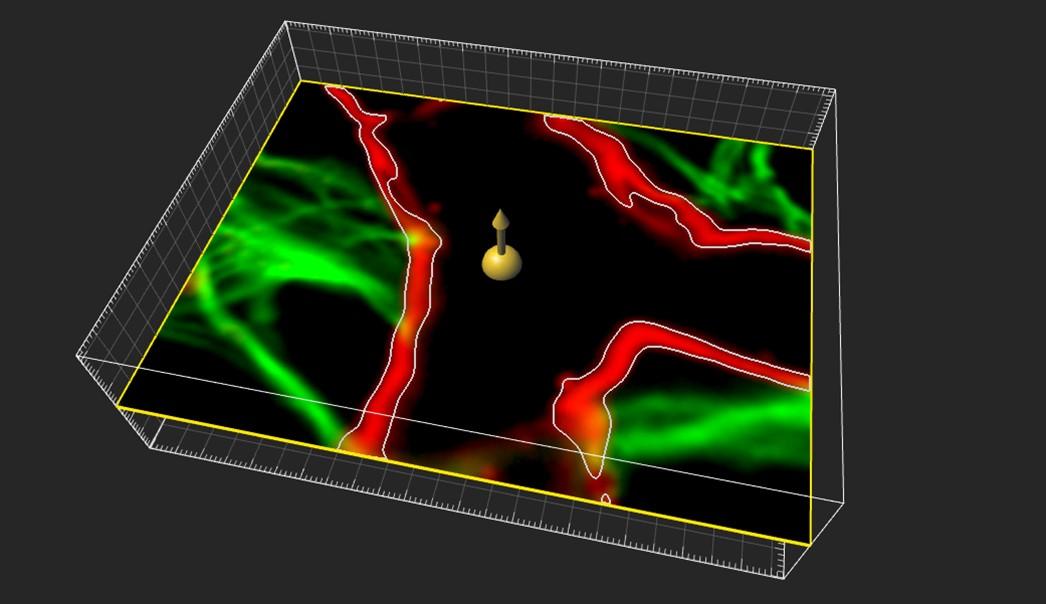
All creation steps can be validated on a slicer (intermediate segmentation steps, region threshold, seed points, etc.). When multiple elements are rendered at the same time during creation (e.g. spots and threshold, or filaments’ dendrites’ line and threshold), all of them are rendered on the same slicer (and with same extended section settings), to give a view of the correlation between these elements.

An important feature of the slicer rendering is its capability to render “extended sections”. When this is enabled, the slicer renders a projection of all volume data (MIP projection) and object data within a specified thickness onto the slice. One might for example set the thickness of the extended section during spots creation to be roughly the diameter of a spot to allow very efficient visual validation.
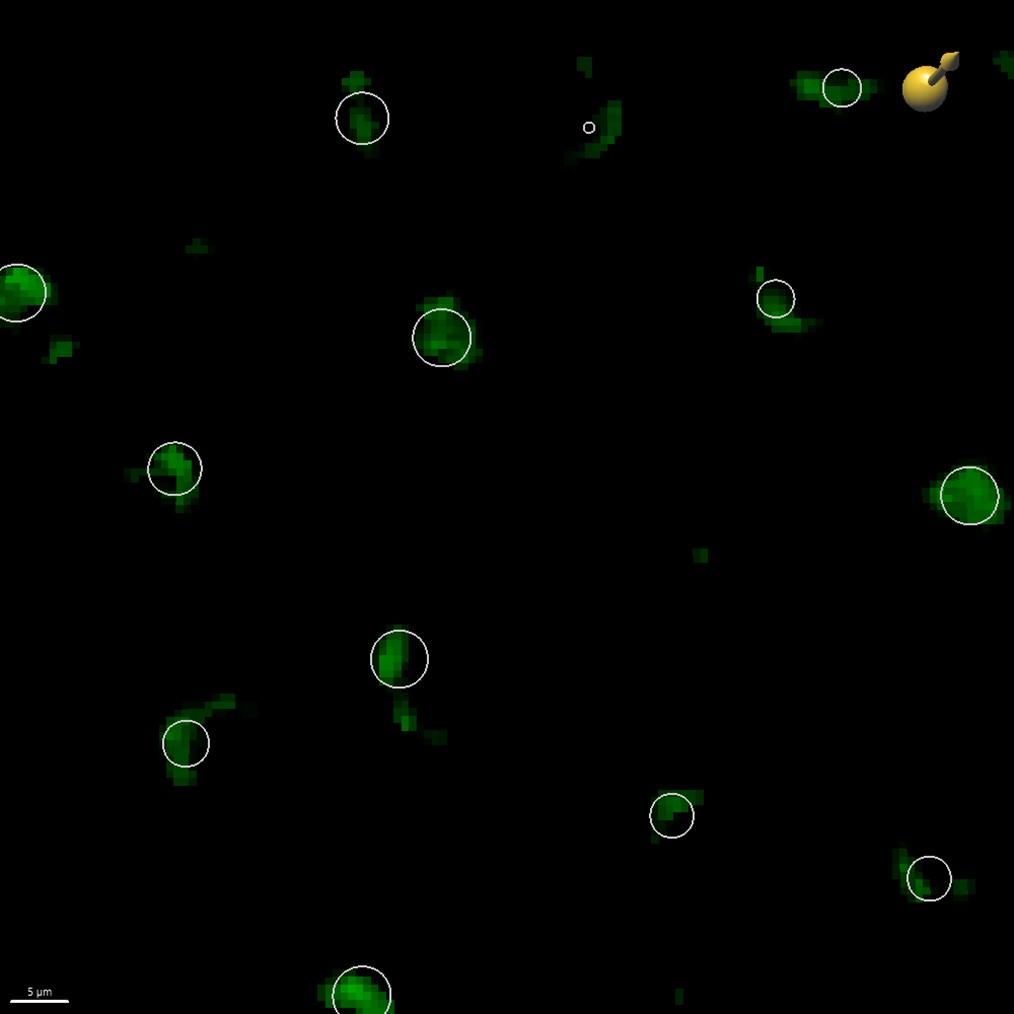
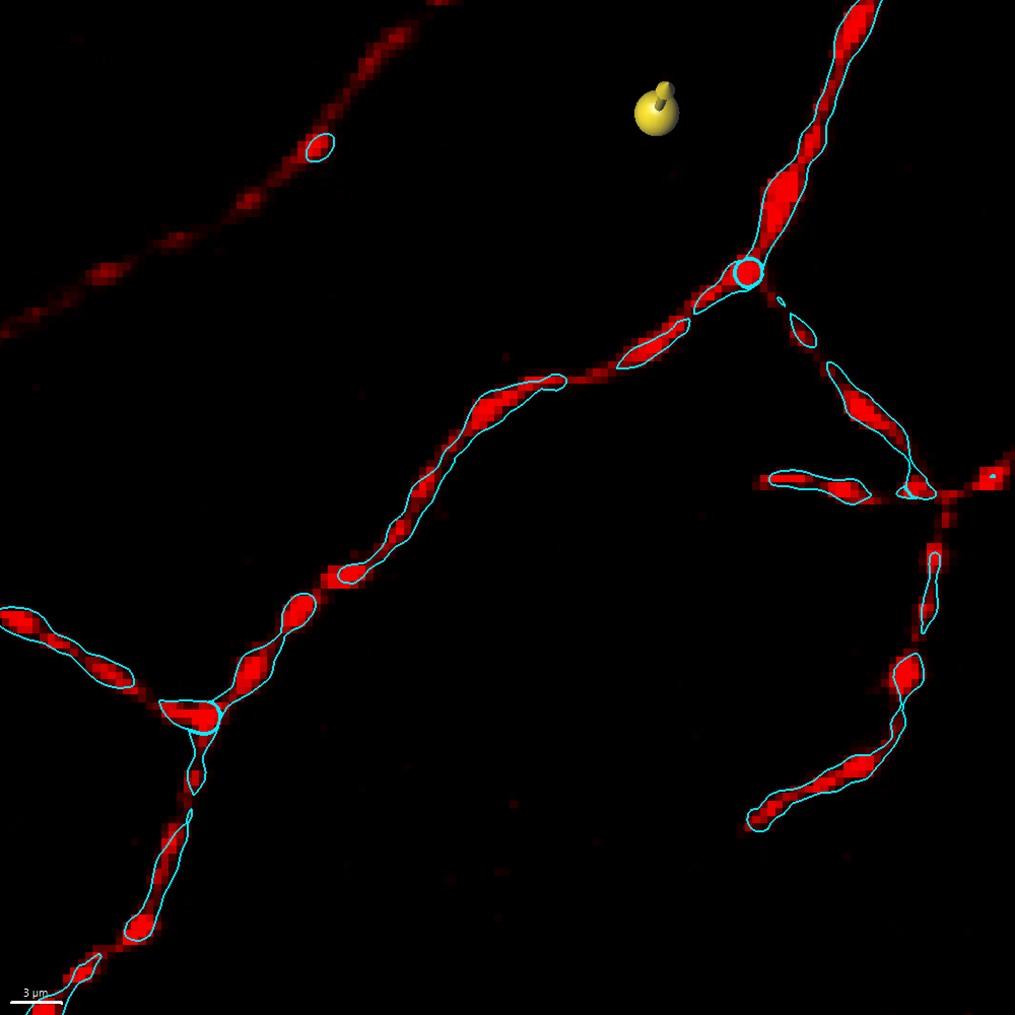
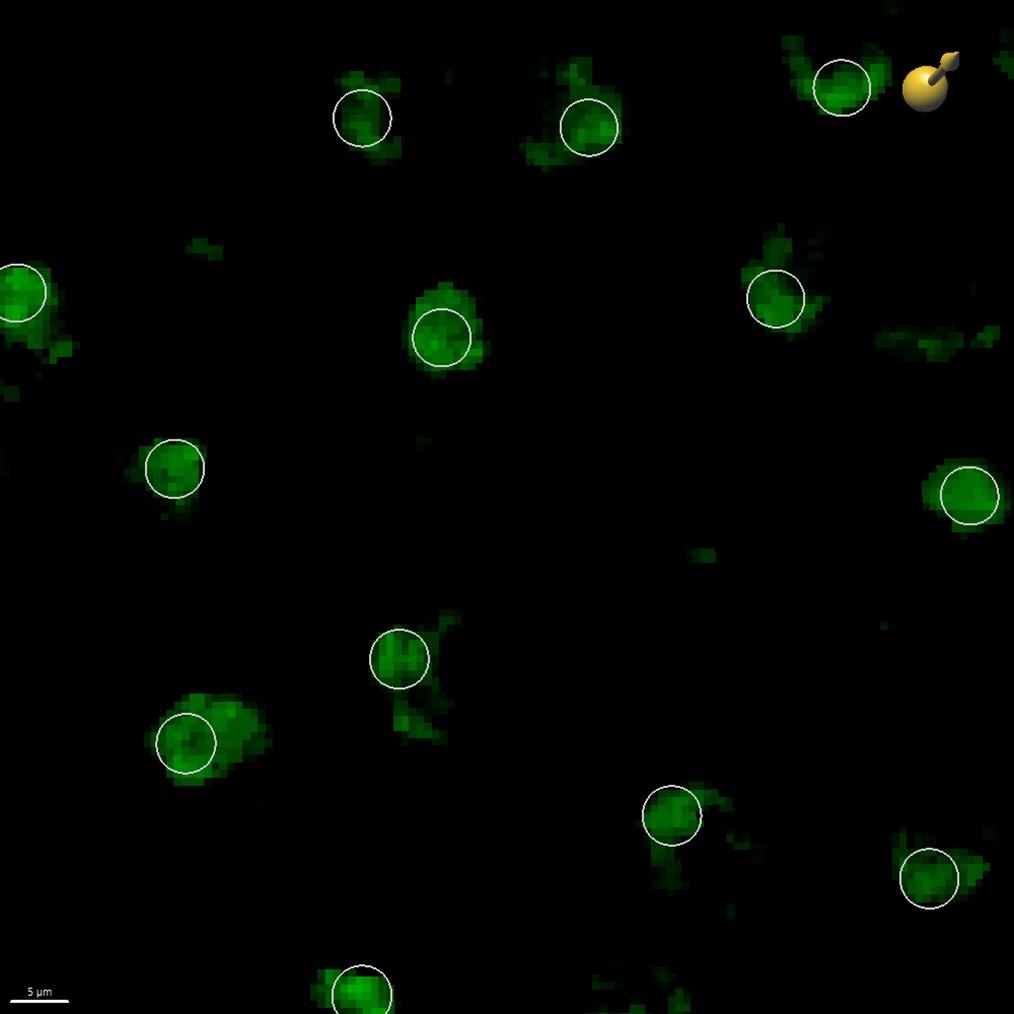
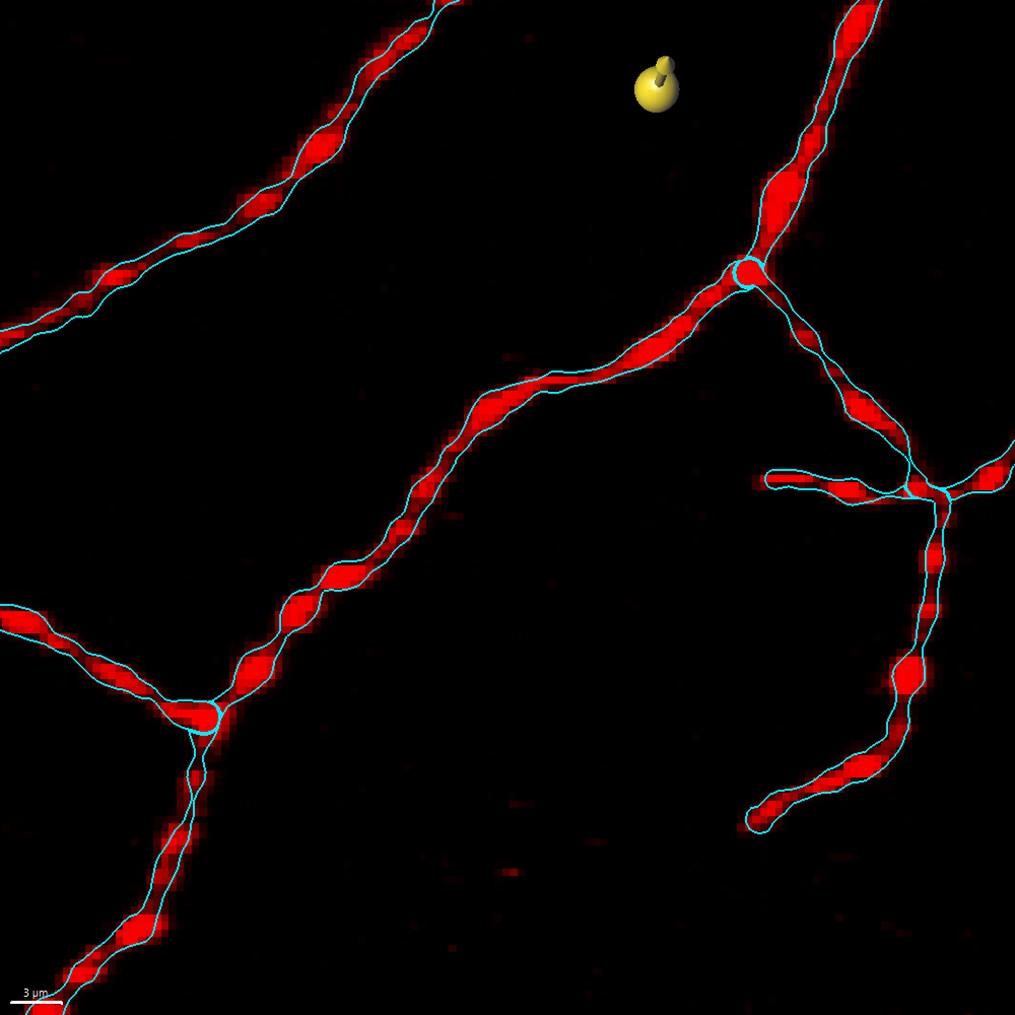
Objects can also be selected and edited in slicer mode. When in circle selection mode the cursor only selects objects displayed on the slice. Objects Slicers can be used in animations. Slicer position, direction and extended section are interpolated between key frames.
In the slicer mode spots are rendered as circles (or ellipses) on a slicer together with the original image data. During spots manual editing you can shift-click onto an existing spot to delete it or shift-click onto the slicer to create a new spot. New spots are automatically positioned at their best “depth” from the slicer when the slicer thickness (extended section) is greater than a single slice. This can make spot positioning very efficient. You can set the slicer extended section to cover a useful thickness (larger than a spot diameter but small enough to not show too much clutter) and rely on the auto-depth positioning algorithm to automatically position each spot at its correct distance from the slicer.
In the slicer mode, filaments can be rendered either as a line, cylinder, or cone (similar options as when rendered in 3D). During filaments drawing with AutoPath the cursor is automatically placed on the slice. Starting point and end point are automatically placed at the optimal position within the thickness of the slicer (in the direction orthogonal to the slicer). During filaments drawing with AutoDepth, the slicer position follows the tracing.
During filaments drawing sometimes parts of the line are outside of the extended slicer. In this case line segments outside the extended section are rendered with transparency: a semi-transparent dashed line means that the segment is below the slicer, a semi-transparent full line means that the segment is above the slicer. The line segments within the extended section are rendered fully opaque.
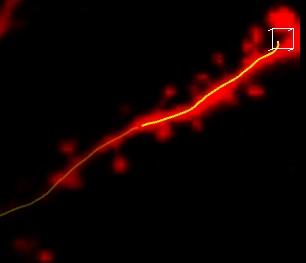
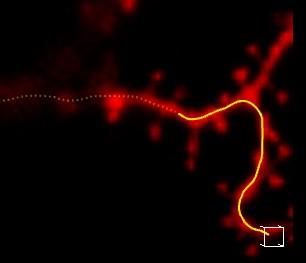
When objects are tracked, tracks are also rendered on the slice.
Surfaces and cells have been adapted to become consistent with the spots and filaments slicers in terms of rendering modes, extended section, and UI options. It is now possible to render surfaces with only an outline which improves segmentation validation.
During surfaces manual edit (Add/Delete, in the edit tab), the cursor is automatically placed on the slice. New surfaces (computed with marching cubes or magic wand) are however not created exactly on the slice, but at their optimal position within the thickness of the slicer (in the direction orthogonal to the slicer). If a specific channel is selected for the auto-depth placement (edit tab), only this channel will be used to define the optimal position, otherwise all visible channels will be used.
Imaris 9.8 automatically hides the Volume component when slicer rendering is turned on.
In case of a specific workflow requiring simultaneous visualization of a slicer and the volume, the “auto-hide” functionality can be disabled in the volume settings tab.
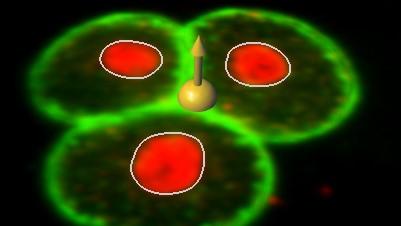
A new manipulator for orthogonal slicers, oblique slicers and clipping planes brings the same simple positioning logic to all slicers:
The manipulator can also be moved within the slicer to prevent it from hiding an area of interest. This can be achieved either by doing right-click and drag on the manipulator sphere, or by doing a right-click somewhere on the slice.
Imaris 9.8 has been optimized to take full advantage of the second scroll wheel provided by the Logitech MX Master mouse while working on slicers. The second wheel translates (the position of) selected slices. This improves efficiency while validating or editing objects, as precise slicer control is now possible without moving the cursor from the scene. This additional control is also available for touch-surfaces and touchpads, the vertical (principal) scroll keeps the usual behavior (zoom and cursor resizing) and the horizontal scroll translates slices.
Shortcuts and interactions related to slicers are now unified so they are available for both orthogonal and oblique slicers, and for any usage of the slicers.
A toolbar is now available next to the objects dialog. It provides an easy and quick way to apply actions on the currently selected component from any objects’ tab.
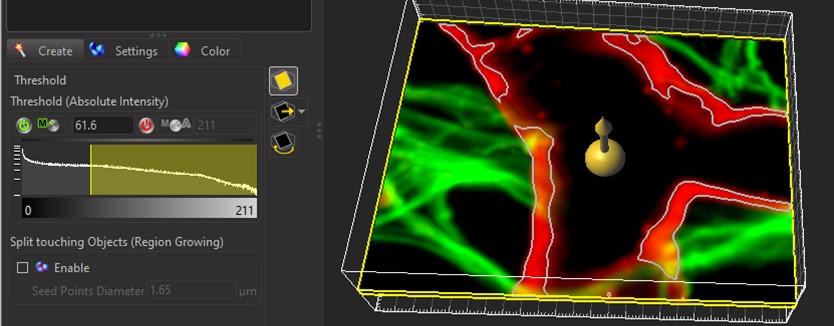
One particularly useful action that it provides is to change slicer mode during object creation without a need to switch to the settings tab.
It also provides tools to facilitate interactions with the slicer. It is thereby possible to translate the slicer to the center of the currently selected objects, to align the slicer to an orthogonal direction, or to store (and recall later) slicer configuration (position, direction and extended section) to come back later to a place of interest.
Imaris 9.8 has a soma model for filaments that aims to capture the correct shape of the soma.
In the creation wizard Soma positions are detected using spots (starting points) just as in previous versions of Imaris.
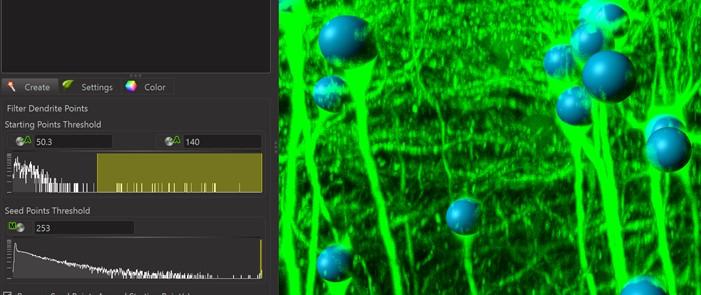
Subsequently Imaris9.8 computes a soma model with a shape around each soma position.

The computation of the soma shape requires a good staining of the soma itself. If you discover that the detected soma shape is not a good representation of the biological shape you can disable the Soma model and use beginning points instead. (Note that it is possible to import a soma model from a surface on the Filaments Edit tab.) Filaments detected with previous versions of Imaris will continue to be compatible with Imaris 9.8.
The filaments edit tab now integrates a soma editing functionality. It allows to semi-automatically create somas. After pressing Shift+Click a soma will automatically be created at the position of the 3D cursor in the 3D scene. The size of the 3D cursor determines the image volume within which the soma will be computed. It is possible to change its size either from the edit dialog, or directly within the 3d view by using the main mouse scroll wheel.
If an existing filament is below the cursor, the Soma will be placed at the center of the filament point below the mouse, and will be automatically connected to the filament. This is particularly useful to replace a begin point by a Soma.
Automatic filaments computation can be done on manually edited somata (and on somata imported from surfaces), by recomputing filaments from the Dendrites step within Creation tab.
When a filament has a soma the lengths of branches and distances from soma are calculated from the border of the soma. A soma model thereby improves the accuracy of dendrite measurements.
The soma model itself produces new statistics in Imaris 9.8: volume, area, ellipticity, sphericity, channel intensity statistics, distance from origin, bounding box lengths, ellipsoid axes, ellipsoid axes lengths, center of mass, center of homogeneous mass.
Filaments rendering performance have been improved in Imaris 9.8, without visual impact on the rendering itself.
Statistics in preferences are now gathered into sub-groups. This gives a better overview of the activation states and provides an easy way to enable/disable all statistics of the same type.
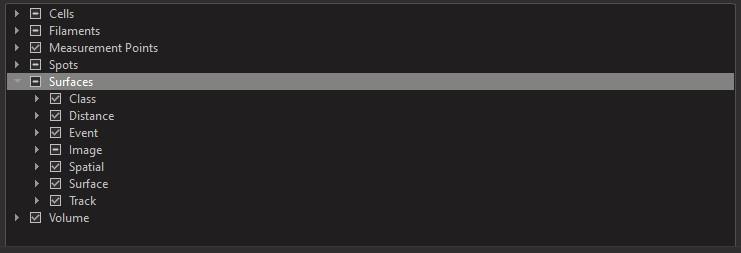
| 58 Bugs Fixed in Imaris 9.8 | |
| 6969 | Automatically detect Web Proxy Configuration directly from the System Settings |
| 10201 | Slicer view does not become active on OS-X due to very old OpenGL version |
| 10610 | Licenses Widget does not register checkbox changes made with SPACE |
| 11086 | Handles for External object should be able to be hidden in animation |
| 11356 | External Object can not be positioned correctly |
| 11548 | Installed application names on Windows Start menu are inconsistent |
| 11841 | ND file with multiple stage positions 3D over time |
| 11897 | Changing Filament base color triggers too many GUI refreshes |
| 12041 | Selection pointer on edit tab of spots not working with Volume off |
| 12054 | Imaris should not start with Deconvolution-only license |
| 12119 | Stitcher remains in half disabled mode when stitching these images |
| 12275 | In track editor the tracks are extremely stretched along the time axis |
| 12279 | Surface Tracks are not visible in Surface Slicer View |
| 12373 | Ability to "Select All" is no longer possible in 9.6 |
| 12558 | Random blocks and splashes appear in surface slicer view |
| 12569 | ND2 is not converted properly - inverts Z slice sequence of second channel in Imaris 9.6 and 9.7 |
| 12578 | lineage track time plot incorrect |
| 12582 | Using 'Resample' in 'Add Time Point...' will cause strange error message and locks up Imaris |
| 12606 | Export External Objects doesn't work for Spots since Imaris 9.2 |
| 12613 | Interaction with Label Editor is strange |
| 12623 | Artifact of tracks displayed when track style is line |
| 12635 | Surpass Tree selection is not correctly updated when changing selection from multiple to single object |
| 12640 | Volume statistics incorrect after clicking on object statistics |
| 12655 | Wrong instruction if there is no license and not internet connection |
| 12663 | ImarisFileConverter becomes unresponsive when modifying the Output Folder Line Edit |
| 12664 | FileConverter does not correctly convert these ome.tiff files |
| 12664 | FileConverter does not correctly convert these ome.tiff files |
| 12666 | Super Resolution data to spots XTension creates an ims file that can't be saved |
| 12669 | Remove Arena option from installer |
| 12683 | ImarisViewer crashes when opening this file |
| 12687 | Histogram does not show data and is not interactive for surfaces detected on this image |
| 12692 | Label color widget is black when loading image with labelled spots |
| 12693 | Filter using "Track Shortest Distance to Surface" freezes imaris |
| 12700 | The first and last slice of the surface ortho slicer preview is always black |
| 12710 | Imaris creates an incorrect histogram when converting these .tiffs |
| 12734 | Imaris crashes when changing the observed folder list while it is processing a large folder |
| 12744 | Reference Frame statistics are not updated when changing Reference Frame name |
| 12747 | Switching to 'Time Since...' Events in the 'Time View' of Vantage will block Imaris for hours! |
| 12749 | Preferences > Statistics need subgroups for easier selections |
| 12754 | This *.iv file couldn't be loaded as external object |
| 12755 | Export Average Statistics - Missing components |
| 12767 | Going back to previous step in filament loops algorithm crashes Imaris |
| 12775 | Imaris couldn't convert this 3D .nd2 file with one DIC slice correctly |
| 12779 | If group folder (with Spots/Surface Object inside) is placed above "volume" in Surpass scene, snapshot cause fatal Imaris crash |
| 12783 | Detailed statistics tab has all stats values filled even when no Spots are created |
| 12788 | cannot convert nd file |
| 12799 | reference frame stats are not updated after deleting spots |
| 12800 | newly saved spot object disappears |
| 12801 | Origin setting not work on 3D view when using 2D dataset |
| 12804 | Imaris will quit when saving the animation if the file name contains Chinese characters |
| 12817 | Batch does not create Spots or Surfaces for specific files |
| 12827 | Creation Parameters can not be saved if "/" is used in the name |
| 12844 | Number of objects per Event under Event tab and Statistics tab don't match |
| 12845 | Slow rendering of large, remote images in Imaris 9.0.2 and later |
| 12904 | XT Interface GetVersion should provide the build number and OS as well |
| 12906 | Tracked Surface created via XT is not finish and shows Create tab |
| 12957 | Color coding errors after duplicating a filament |
| 12975 | Preview in Stitcher after alignment does not match what you see in Imaris after save to ims |
| Fixed 4 Bugs (since Imaris 9.8.0) | |
| 13016 | Evaluation license deactivates on customer side after one use |
| 13079 | Statistic selection in preferences not used in statistic tab |
| 13090 | Filament duplicate is crashing Imaris |
| 13130 | Imaris crashes when you move time slider when visualize seedpoints on slicer |
| Fixed 2 Bugs (since Imaris 9.8.1) | |
| 13161 | Imaris 9.8.1 XTensions are broken |
| 13162 | FIJI bridge file is not working in Imaris 9.8.1 |